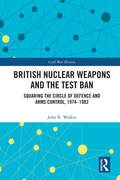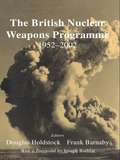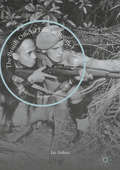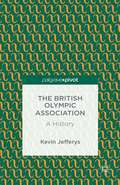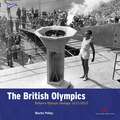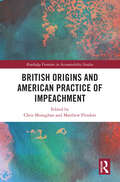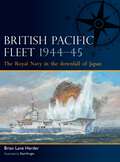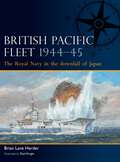- Table View
- List View
British Nuclear Weapons and the Test Ban: Squaring the Circle of Defence and Arms Control, 1974-82 (Cold War History)
by John R. WalkerThis book provides an overview of how the UK tried to maintain and modernize its strategic and tactical nuclear weapons during 1974-82, whilst also pursuing a comprehensive nuclear test ban treaty. The core question addressed in the book is how a test ban treaty would impact on the reliability and safety of the UK’s nuclear weapons and how this would constrain and limit efforts to secure a comprehensive treaty that would prohibit nuclear testing indefinitely. An added complication lay in the fact that a ban treaty could also prevent or limit the UK’s ability to test new warhead designs to replace its existing tactical nuclear weapons and a new strategic successor system to Polaris. How all of this played out between 1974 and 1982, when the UK announced its decision to acquire Trident and the US decided that a test ban treaty was no longer in its security interests, is discussed. A detailed review, based on the available materials in the UK National Archives, also looks at the aims and objectives of UK nuclear tests in Nevada and on the decisions taken on the Chevaline warhead and its Trident replacement. The book also considers whether there was a far greater threat to the UK nuclear programme from shortages of skilled craftsmen and industrial action at the Atomic Weapons Establishment at Aldermaston than from a test ban treaty. It also looks at whether nuclear defence trumped arms control objectives during this period. This book will be of much interest to students of British politics, nuclear proliferation and Cold War History.
British Nuclear Weapons and the Test Ban: Squaring the Circle of Defence and Arms Control, 1974-82 (Cold War History)
by John R. WalkerThis book provides an overview of how the UK tried to maintain and modernize its strategic and tactical nuclear weapons during 1974-82, whilst also pursuing a comprehensive nuclear test ban treaty. The core question addressed in the book is how a test ban treaty would impact on the reliability and safety of the UK’s nuclear weapons and how this would constrain and limit efforts to secure a comprehensive treaty that would prohibit nuclear testing indefinitely. An added complication lay in the fact that a ban treaty could also prevent or limit the UK’s ability to test new warhead designs to replace its existing tactical nuclear weapons and a new strategic successor system to Polaris. How all of this played out between 1974 and 1982, when the UK announced its decision to acquire Trident and the US decided that a test ban treaty was no longer in its security interests, is discussed. A detailed review, based on the available materials in the UK National Archives, also looks at the aims and objectives of UK nuclear tests in Nevada and on the decisions taken on the Chevaline warhead and its Trident replacement. The book also considers whether there was a far greater threat to the UK nuclear programme from shortages of skilled craftsmen and industrial action at the Atomic Weapons Establishment at Aldermaston than from a test ban treaty. It also looks at whether nuclear defence trumped arms control objectives during this period. This book will be of much interest to students of British politics, nuclear proliferation and Cold War History.
The British Nuclear Weapons Programme, 1952-2002
by Frank Barnaby Douglas HoldstockThe first British nuclear weapon test took place in Australia in October 1952. British nuclear weapons have been a source of controversy ever since. In this book, scientists, doctors, researchers and others assess the military value, political impact, health effects and legality of the programme.
The British Nuclear Weapons Programme, 1952-2002
by Douglas Holdstock Frank BarnabyThe first British nuclear weapon test took place in Australia in October 1952. British nuclear weapons have been a source of controversy ever since. In this book, scientists, doctors, researchers and others assess the military value, political impact, health effects and legality of the programme.
The British Officer: Leading the Army from 1660 to the present
by Anthony ClaytonAn Army officer must lead men into frightening and dangerous situations and sometimes make them do things that they never thought they could do. This book recounts how British officers have led their men, and commanded their respect, from the days of Marlborough to the Second Iraq war of 2003. Anthony Clayton explores who the officers, men and now women, have been and are, where they came from, what ideals or traditions have motivated them, and their own perceptions of themselves. His account tells the fascinating story of how the role of the military officer evolved, illustrated by a selection of captivating images, and the personal memoirs, biographies and autobiographies of officers.
The British Officer: Leading the Army from 1660 to the present
by Anthony ClaytonAn Army officer must lead men into frightening and dangerous situations and sometimes make them do things that they never thought they could do. This book recounts how British officers have led their men, and commanded their respect, from the days of Marlborough to the Second Iraq war of 2003. Anthony Clayton explores who the officers, men and now women, have been and are, where they came from, what ideals or traditions have motivated them, and their own perceptions of themselves. His account tells the fascinating story of how the role of the military officer evolved, illustrated by a selection of captivating images, and the personal memoirs, biographies and autobiographies of officers.
The British Official Film in South-East Asia: Malaya/Malaysia, Singapore and Hong Kong
by Ian AitkenThis book explores the ways in which the British official film was used in Malaya/Malaysia, Singapore and Hong Kong from 1945 to the 1970s. Aitken uncovers how the British official film, and British official information agencies, adapted to the epochal contexts of the Cold War and end of empire. In addition to an extensive introduction, which touches on a number of critical issues related to the post-war British official film, the book provides an account of how the tradition of film-making associated with the British documentary film movement spread into the region during the post-war period, and how that tradition was contested by a ‘Colonial Office’ tradition of film-making. The volume concludes by covering the rise of television in the region within the context of developing post-colonial authoritarian states in Singapore and Malaysia, and the continuation of colonial authoritarianism in Hong Kong.
The British Olympic Association: A History
by K. JefferysSince its creation the British Olympic Association (BOA) has been one of the most important institutions in sports governance. In spite of its prominence there has hitherto been no single-volume history of the Association. This scholarly yet accessible study fills that gap, assessing the origins, evolution, strengths and shortcomings of the BOA.
The British Olympics: Britain's Olympic Heritage 1612-2012 (Played in Britain #10)
by Martin PolleyHistory records that the Olympic Games originated in ancient Greece nearly three thousand years ago, died out around 393 AD, and were triumphantly reborn in 1896, in the Greek capital of Athens. Rather less well known is how, during the intervening centuries, an assortment of British writers, romantics, sportsmen and visionaries helped nurture that revival. Indeed, as sports historian Dr Martin Polley argues in this, the 12th book in the acclaimed Played in Britain series, our nation’s fascination with all things Olympian has played a pivotal role in shaping the Games as we know them today, culminating in London becoming in 2012 the first city ever to stage a third modern Olympiad. Consider, for example, that the first published use of the word ‘Olympian’ in the English language dates from around 1590. Its author? William Shakespeare. And that the first games of the post-classical era to adopt the formal title ‘Olympick’ took place in the Cotswolds village of Chipping Campden in 1612. It was an English traveller, Richard Chandler, who rediscovered the lost site of Olympia in 1766, and a Shropshire doctor, William Penny Brookes, who, in 1850, founded the Much Wenlock Olympian Games, an annual community festival that inspired Pierre de Coubertin to revive the Games at an international level. Other Olympic festivals surfaced in London (to celebrate Queen Victoria’s accession), in Liverpool, and in the north-east town of Morpeth, while the words ‘Olympic’ and ‘Olympian’ became steadily more ingrained in the popular imagination throughout the Victorian era. Britain’s Olympic heritage gained added momentum in the 20th century. At White City in 1908, London built the world’s first modern, purpose-built Olympic stadium, while in 1948 London stepped in to save the Games by offering Wembley Stadium. Also in the late 1940s, at Stoke Mandeville hospital in Buckinghamshire, the modern Paralympics were born when sporting contests were organised for injured servicemen. Thus the 2012 Games represent the culmination of over four hundred years of British enthusiasm and ingenuity; an attachment that has left in its wake a trail of fascinating stories, characters, sites, buildings and artefacts. Leading the reader on a marathon journey, The British Olympics charts them all, making this a vital and entertaining source for anyone with an interest in the Games, in sport, and in the wider narrative of Britain’s social and cultural heritage.
British Origins and American Practice of Impeachment (Routledge Frontiers in Accountability Studies)
by Chris Monaghan and Matthew FlindersThis collection brings together historians, political scientists and legal scholars to explore the Anglo-American origins of impeachment and its use in the USA. Impeachment originated in England during the Good Parliament of 1376. It was used, subject to several periods of disuse, until the beginning of the 19th century. The British form of impeachment in turn inspired the drafters of the US Constitution and the inclusion of a mechanism permitting the removal of members of the federal executive and federal judiciary. These Anglo-American origins of impeachment have inspired many constitutions around the globe to include impeachment mechanisms which permit, in most cases, the legislature to remove the President, a Prime Minister, ministers and judges. This volume explores the origins, influence and practice of impeachment. Divided into three parts, the history of impeachment and how it developed in British history is the focus of part one. The inclusion of Ireland reflects the constitutional status of impeachment, the legacy of union with Great Britain and how impeachment can still serve as a deterrent. Part two examines the adoption of impeachment within the US Constitution and its use in practice. The third and final part discusses impeachment in the 21st century. The book will be an essential resource for students, academics and researchers in law, political science and history.
British Origins and American Practice of Impeachment (Routledge Frontiers in Accountability Studies)
This collection brings together historians, political scientists and legal scholars to explore the Anglo-American origins of impeachment and its use in the USA. Impeachment originated in England during the Good Parliament of 1376. It was used, subject to several periods of disuse, until the beginning of the 19th century. The British form of impeachment in turn inspired the drafters of the US Constitution and the inclusion of a mechanism permitting the removal of members of the federal executive and federal judiciary. These Anglo-American origins of impeachment have inspired many constitutions around the globe to include impeachment mechanisms which permit, in most cases, the legislature to remove the President, a Prime Minister, ministers and judges. This volume explores the origins, influence and practice of impeachment. Divided into three parts, the history of impeachment and how it developed in British history is the focus of part one. The inclusion of Ireland reflects the constitutional status of impeachment, the legacy of union with Great Britain and how impeachment can still serve as a deterrent. Part two examines the adoption of impeachment within the US Constitution and its use in practice. The third and final part discusses impeachment in the 21st century. The book will be an essential resource for students, academics and researchers in law, political science and history.
British Pacific Fleet 1944–45: The Royal Navy in the downfall of Japan (Fleet #3)
by Brian Lane HerderAn illustration-packed new account of the powerful Royal Navy fleet that fought alongside the US Navy throughout the last year of the Pacific War.The British Pacific Fleet was the Royal Navy's primary contribution to the direct defeat of Japan in 1945, and is among the most powerful fleets Britain has ever sent into action. With naval supremacy in home waters achieved by 1944, many of the best and most modern ships in the Royal Navy could be sent to the Pacific, including battleships, submarines, light forces, replenishment groups, and shore establishment. However, the main striking force was the fast carrier force.Illustrated throughout with dramatic new artwork, 3D diagrams, maps and archive photos, this book explains how the Royal Navy joined the Pacific carrier war, and how the fleet adopted the US Navy's ruthlessly effective fast carrier doctrine. With ships optimized for short-range operations in the Atlantic and Mediterranean, the BPF had to rapidly adapt to the long-range, high-tempo warfare of the Pacific, and the story is often one of inspired improvisation. The BPF shared the US Navy's terrifying experience of kamikaze strikes, and famously its armoured carriers proved tougher than the US counterparts. With discussion of the ships, their technology, how the fleet was organized and commanded, and how it fought the campaign, this book is a fascinating exploration of the Royal Navy's part in the victory over Japan.
British Pacific Fleet 1944–45: The Royal Navy in the downfall of Japan (Fleet #3)
by Brian Lane HerderAn illustration-packed new account of the powerful Royal Navy fleet that fought alongside the US Navy throughout the last year of the Pacific War.The British Pacific Fleet was the Royal Navy's primary contribution to the direct defeat of Japan in 1945, and is among the most powerful fleets Britain has ever sent into action. With naval supremacy in home waters achieved by 1944, many of the best and most modern ships in the Royal Navy could be sent to the Pacific, including battleships, submarines, light forces, replenishment groups, and shore establishment. However, the main striking force was the fast carrier force.Illustrated throughout with dramatic new artwork, 3D diagrams, maps and archive photos, this book explains how the Royal Navy joined the Pacific carrier war, and how the fleet adopted the US Navy's ruthlessly effective fast carrier doctrine. With ships optimized for short-range operations in the Atlantic and Mediterranean, the BPF had to rapidly adapt to the long-range, high-tempo warfare of the Pacific, and the story is often one of inspired improvisation. The BPF shared the US Navy's terrifying experience of kamikaze strikes, and famously its armoured carriers proved tougher than the US counterparts. With discussion of the ships, their technology, how the fleet was organized and commanded, and how it fought the campaign, this book is a fascinating exploration of the Royal Navy's part in the victory over Japan.
The British Pacific Fleet Experience and Legacy, 1944–50
by Jon Robb-WebbThe British Pacific Fleet was formed in October 1944 and dispatched to fight alongside the USN in the Central Pacific under Admiral Nimitz. Deploying previously unpublished documents, this book reveals how relations between the UK and US forces developed from a starting point of barely repressed suspicion, to one where both navies came to understand each other and eventually find a remarkable bond. Born out of a shared experience of Kamikaze attacks, extended operations against bitterly hostile shores, the pooling of knowledge and experience, the two navies underpinned the diplomatic moves in both Washington and London. The book carries the legacy of this experience through to the next Anglo-American participation in war, Korea. It illustrates and explains how and why certain lessons were incorporated into the composition, behaviour and structure of the post-war Navy. It demonstrates the significance of what was learned from the USN by the RN and by USN from the RN. As well as examining the background to the largest fleet the Royal Navy ever put to sea, the book also charts its effects on Anglo-American relations, multinational operations, alliance building, and the ways naval forces are shaped by and in turn shape politics. It addresses a period of rapid technological development that witnessed profound changes in the international system, and which raised fundamental questions of what navies were for and how should they operate and organize themselves. In so doing the study illustrates how the experience of a few long months at the end of the war in the Pacific would cast a long shadow over these issues in the very different circumstances of the post-war world.
The British Pacific Fleet Experience and Legacy, 1944–50
by Jon Robb-WebbThe British Pacific Fleet was formed in October 1944 and dispatched to fight alongside the USN in the Central Pacific under Admiral Nimitz. Deploying previously unpublished documents, this book reveals how relations between the UK and US forces developed from a starting point of barely repressed suspicion, to one where both navies came to understand each other and eventually find a remarkable bond. Born out of a shared experience of Kamikaze attacks, extended operations against bitterly hostile shores, the pooling of knowledge and experience, the two navies underpinned the diplomatic moves in both Washington and London. The book carries the legacy of this experience through to the next Anglo-American participation in war, Korea. It illustrates and explains how and why certain lessons were incorporated into the composition, behaviour and structure of the post-war Navy. It demonstrates the significance of what was learned from the USN by the RN and by USN from the RN. As well as examining the background to the largest fleet the Royal Navy ever put to sea, the book also charts its effects on Anglo-American relations, multinational operations, alliance building, and the ways naval forces are shaped by and in turn shape politics. It addresses a period of rapid technological development that witnessed profound changes in the international system, and which raised fundamental questions of what navies were for and how should they operate and organize themselves. In so doing the study illustrates how the experience of a few long months at the end of the war in the Pacific would cast a long shadow over these issues in the very different circumstances of the post-war world.
British Pamphlets on the American Revolution, 1763-1785, Part I, Volume 1
by Harry T DickinsonFirst published in 2007, this collection presents a selection of British pamphlets, which represent the multi-faceted debate on both sides of the political divide in Britain. The pamphlets in this work are organised chronologically in two parts, taking the start of American armed resistance in 1775 as the dividing point. Volume 1 covers the period of 1763 to1785.
British Pamphlets on the American Revolution, 1763-1785, Part I, Volume 1
by Harry T DickinsonFirst published in 2007, this collection presents a selection of British pamphlets, which represent the multi-faceted debate on both sides of the political divide in Britain. The pamphlets in this work are organised chronologically in two parts, taking the start of American armed resistance in 1775 as the dividing point. Volume 1 covers the period of 1763 to1785.
British Pamphlets on the American Revolution, 1763-1785, Part I, Volume 2
by Harry T DickinsonFirst published in 2007, this collection presents a selection of British pamphlets, which represent the multi-faceted debate on both sides of the political divide in Britain. The pamphlets in this work are organised chronologically in two parts, taking the start of American armed resistance in 1775 as the dividing point. Volume 2 covers the period of 1766 to 1774.
British Pamphlets on the American Revolution, 1763-1785, Part I, Volume 2
by Harry T DickinsonFirst published in 2007, this collection presents a selection of British pamphlets, which represent the multi-faceted debate on both sides of the political divide in Britain. The pamphlets in this work are organised chronologically in two parts, taking the start of American armed resistance in 1775 as the dividing point. Volume 2 covers the period of 1766 to 1774.
British Pamphlets on the American Revolution, 1763-1785, Part II, Volume 5
by Harry T DickinsonFirst published in 2007, this collection presents a selection of British pamphlets, which represent the multi-faceted debate on both sides of the political divide in Britain. The pamphlets in this work are organised chronologically in two parts, taking the start of American armed resistance in 1775 as the dividing point. Volume 5 covers the period of 1776 to 1778.
British Pamphlets on the American Revolution, 1763-1785, Part II, Volume 5
by Harry T DickinsonFirst published in 2007, this collection presents a selection of British pamphlets, which represent the multi-faceted debate on both sides of the political divide in Britain. The pamphlets in this work are organised chronologically in two parts, taking the start of American armed resistance in 1775 as the dividing point. Volume 5 covers the period of 1776 to 1778.
British Pamphlets on the American Revolution, 1763-1785, Part II, Volume 6
by Harry T DickinsonFirst published in 2007, this collection presents a selection of British pamphlets, which represent the multi-faceted debate on both sides of the political divide in Britain. The pamphlets in this work are organised chronologically in two parts, taking the start of American armed resistance in 1775 as the dividing point. Volume 6 starts Part II and covers the period of 1778.
British Pamphlets on the American Revolution, 1763-1785, Part II, Volume 6
by Harry T DickinsonFirst published in 2007, this collection presents a selection of British pamphlets, which represent the multi-faceted debate on both sides of the political divide in Britain. The pamphlets in this work are organised chronologically in two parts, taking the start of American armed resistance in 1775 as the dividing point. Volume 6 starts Part II and covers the period of 1778.
British Pamphlets on the American Revolution, 1763-1785, Part II, Volume 7
by Harry T DickinsonFirst published in 2007, this collection presents a selection of British pamphlets, which represent the multi-faceted debate on both sides of the political divide in Britain. The pamphlets in this work are organised chronologically in two parts, taking the start of American armed resistance in 1775 as the dividing point. Volume 7 is in Part II and covers the period of 1779 to1782.
British Pamphlets on the American Revolution, 1763-1785, Part II, Volume 7
by Harry T DickinsonFirst published in 2007, this collection presents a selection of British pamphlets, which represent the multi-faceted debate on both sides of the political divide in Britain. The pamphlets in this work are organised chronologically in two parts, taking the start of American armed resistance in 1775 as the dividing point. Volume 7 is in Part II and covers the period of 1779 to1782.
